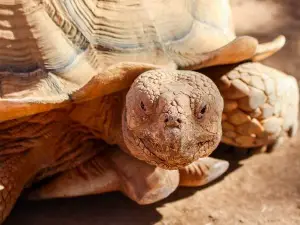
Tortoises are quite fascinating creatures, they are known for their slow movements and their slow nature, but they aren’t exactly known to be completely stiff
If your tortoise is stiff then you’d understandably be worried and wonder why, this article looks into why this happens
Table of Contents
Why is my tortoise stiff?
If you do regular health checkups on your tortoise then you’ll quickly pick up if you’re pet starts acting oddly, one example of odd behavior in your pet tortoise is the animal being stiff
Here is why your tortoise may be stiff:
Hibernating:
One reason why your pet tortoise May be stiff may be that the animal is hibernating. This process happens for about four to six weeks in wild tortoises but the hibernation period in pet tortoises is usually shorter
The hibernation process for these animals makes them less active and this leads them to develop stiffness in their limbs.
During this time, the animals will shorten their metabolism down to almost nothing, they will also breathe very slowly and drop their heart rate.
The animals will also stop eating and drinking and their body temperature will decrease significantly.
What to do:
This is normal behavior and isn’t something that you should worry about
What is recommended for your tortoise is that you flush the urates from the animal’s body by giving the animal a soak 3-4 times weekly. Doing this also helps to hydrate the animal.
It is also recommended that you splash small amounts of water on the animal’s head and shell to help hydrate them.
The animal will come out of its hibernation when the temperature gets warmer.
The animal has passed:
If you find that your pet is not only stiff but is also cold and unresponsive then the animal may be dead.
The stiffening that you may see in your pet is likely rigor mortis setting in, rigor mortis is the stiffening of the animal’s body after death.
Other signs that indicate that the animal has passed are sunken eyes. The animal’s body will loosen up after the rigor mortis sets in once all the muscles lose their tension, there may also be an odor after the rigor mortis.
What to do:
You can touch your pet’s eyelid, and eyes, to see if you get a response, if you don’t get a response then the animal is likely dead, animals will respond to touch this when alive.
Other checks that will help you figure out if the animal is dead are: blinking if you blow at the animal’s eyes, the head moving when you touch it, retracting of the legs, react acting when you put water on its head, and movement when you flip the animal upside down.
You can also try soaking your pet in some warm water to see if the animal reacts, if there is no reaction then your pet likely passed.
Wait for 24 hours, to make sure that it doesn’t move at all, before deciding that the reptile is dead.
If you enjoyed this article then you may also be interested in other turtle/tortoise related articles. Here are some articles that you may be interested in: Why Is My Turtle Restless While Sleeping, Why Do Turtles Put Their Feet Up, Why Is My Turtle Restless While Sleeping, My Tortoise Is Not Responding, Why Is My Turtle Swimming Upside Down, Hit My Turtle With A Lawn Mower, What Happens When You Drop A Turtle On Its Back?, Can Turtles Survive A Fall?, Turtle Bleeding From The Bottom Of Shell

